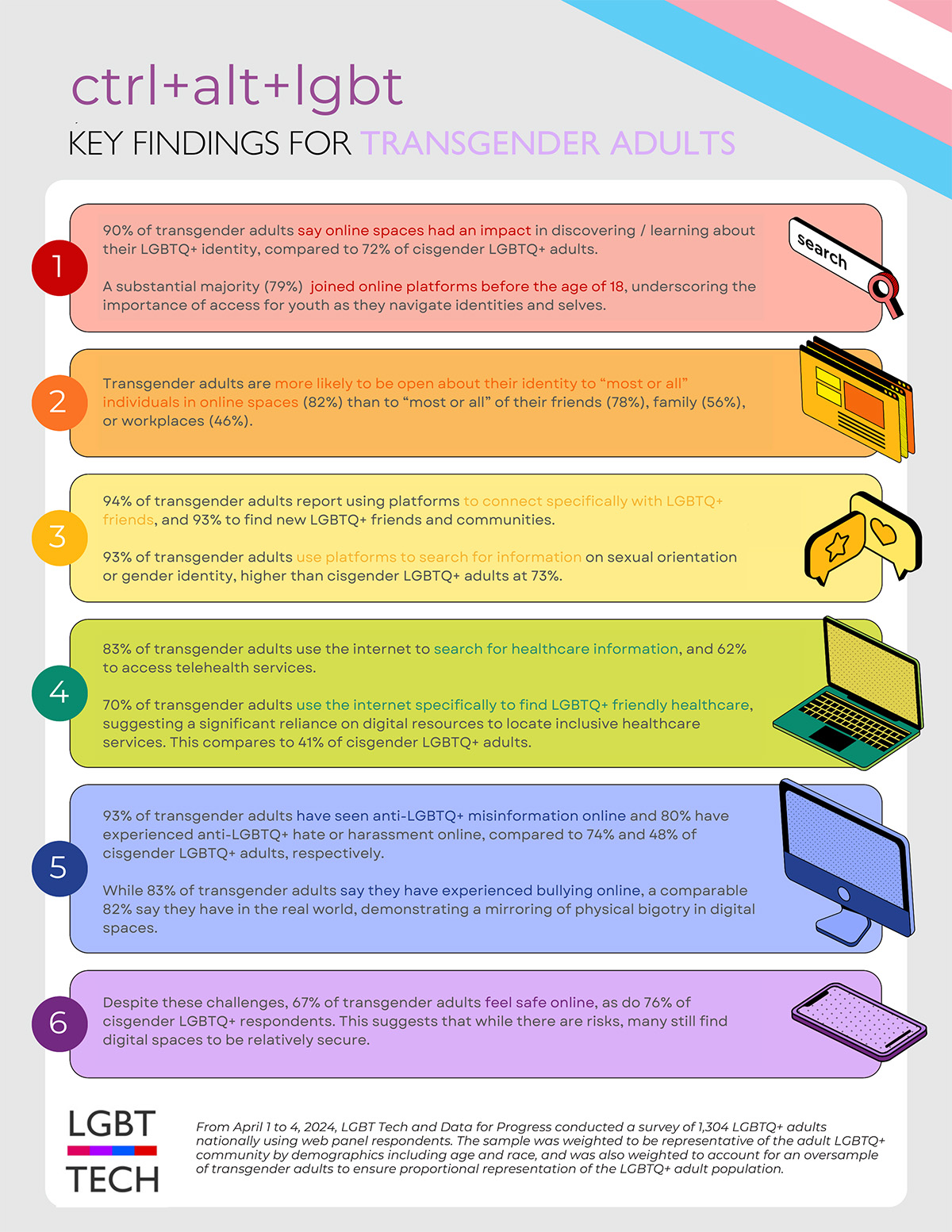Alex, 29, would not have met their friends without the internet. While living in a small city surrounded by farmland, finding community was not always easy.
Alex tried out one of those apps for adults seeking to make friends. It turned out to be a remarkable success. “I’ve made my friend group as a direct result of using the internet,” they said, explaining that even though all the friends are trans, due to their diverse interests, “we would have been hard-pressed to have ever really run into each other by happenstance.”
Making friends online is also safer for Alex. Before they pursued HRT and surgery and looked more “visibly queer,” they were in scary situations. “I’ve had pickup trucks chase me while driving, people call out slurs while driving by me, and I’ve been shot at,” they said.
Having the internet available for appointments, work, and social activities is fundamental to their life.
But the web was not always such a friendly place for Alex. “There’s so much hate and falsehoods out there about trans people,” they said. “It’s why it takes so long for some of us to learn about who we are.”
This dissonance is widespread within the LGBTQ community. A recent report — "ctrl+alt+lgbt: Digital Access, Usage, and Experiences of the LGBTQ+ Community” — by LGBT Tech and Data for Progress provides insight into that phenomenon.
Shae Gardner, director of policy at LGBT Tech, explained that most of the research about the LGBTQ community’s internet use historically has focused on youth. The project aimed to fill the gap. From surveys with 1,300 people across the country, the report found that while the internet is a foundational space for LGBTQ community building and self-expression, it also comes with a high risk for bullying and harassment.
Image courtesy of LGBT Tech.
These findings intensify when looking specifically at the data for underrepresented groups within the LGBTQ population like the transgender community, who are by far the group that faces the most harassment online, per the Anti-Defamation League. Gardner explained that the survey was over-sampled for transgender individuals intentionally. “We really wanted to understand that specific experience,” Gardner said.
The Blade interviewed five trans people about their experiences to gain insight into how different community members felt while navigating the web, and specifically identified sources who do not have public platforms and therefore do not face heightened public scrutiny. Due to concern for backlash, all sources for this story spoke on condition of anonymity with gender-ambiguous names and they/them pronouns.
Four out of five of the people interviewed emphasized that the internet is a vital resource for accessing healthcare.
Riley, 24, explained, “I have such immense dread about transitioning because I don’t want to have to interact with doctors around my identity. I feel like I don’t have access to providers who are able to understand me.”
The internet, for many, provides a safe location to access health information and care without the judgment of doctors. Kai, 23, and Cameron, 27, both shared that the internet was an important place for them to learn specifics around trans healthcare and seek out trans-friendly providers. Alex agreed and added that they have made it so all of their doctors’ appointments through telehealth.
These experiences are consistent with the larger trans community. LGBT Tech’s survey found that 70% of transgender adults use the internet to find LGBTQ-friendly healthcare. By comparison, only 41% of cisgender LGBTQ adults use the internet to find the same friendly care.
All the sources interviewed said they sought LGBTQ community online with varying degrees of success.
Jordan, 24, said that not only is social media a good way to stay connected with people they know, but it also helps them find a broader community. “It’s nice to follow other trans and queer people whose experiences can inspire me or make me feel seen.”
Cameron emphasized that the internet provides connections to activities and communities around town. “Social media has facilitated my in-person queer and trans community,” they explained. “I learn a lot about what queer events are happening around town via social media. I have a wonderful community playing queer sports that I wouldn’t have found without the internet.”
Kai shared that it hasn’t been a successful pursuit for them: “I wish it did more than it does.”
Per Trans Tech’s survey, transgender adults “often” use social media to connect with existing LGBTQ friends and family 41% of the time (as opposed to “sometimes” “rarely” or “never”). This is 21% more than the LGBTQ community at large. The survey also reveals that transgender adults are 20% more likely to “often” use social media to connect with new LGBTQ community than the LGBTQ community at large.
Everyone but Cameron has experienced some form of direct bullying or harassment for being transgender, either online or in person. The survey found that 83% of transgender adults have faced bullying online. By comparison, 59% of the cisgender LGBTQ community faced bullying online.
“Technology is only as good as its application. And this is the other side of the dual-edged sword,” said Gardner.
Gardner explained that the online and in-person harassment was mirrored. “The experiences of anti-LGBTQ bullying were very high, both for LGBTQ+ individuals and especially for trans individuals, but those numbers were nearly equitable to the experiences that they have in the real world with anti-LGBTQ+ bullying,” she said. The survey found that 82% of transgender adults faced bullying in person.
The survey found despite the comparable levels of harassment and high levels of misinformation (93% of transgender adults saw anti-LGBTQ misinformation online), respondents overwhelmingly felt safe online — 67% of trans adults and 76% of cisgender LGBTQ adults.
When she compared this phenomenon to her life, Gardner wasn’t surprised. “The harassment that I have faced online has certainly felt less immediately threatening than what I’ve faced in person. The mental toll it takes is significant, but I would argue individuals probably have an easier time getting away from it.”
That doesn’t stop Gardner from noting, “We need to be fighting [harassment] in both places.”
She explained that, “when we are staring down the barrel of record-setting anti-LGBTQ+ legislation yet again, it is so integral to keep fighting for digital spaces to be as safe as possible.”
Regardless of its safety, it is a space that is a constant for many. “I use the internet constantly,” said Alex. “I use the internet a lot at work since I have a desk job,” said Jordan.
When reflecting on the internet, Riley summed up the tensions they experience. “It can be harrowing often, but simultaneously it’s where I feel a sense of community and access.”
(This story is part of the Digital Equity Local Voices Fellowship lab through News is Out. The lab initiative is made possible with support from Comcast NBCUniversal.)
Los Angeles Blade courtesy of the National LGBTQ Media Association.




